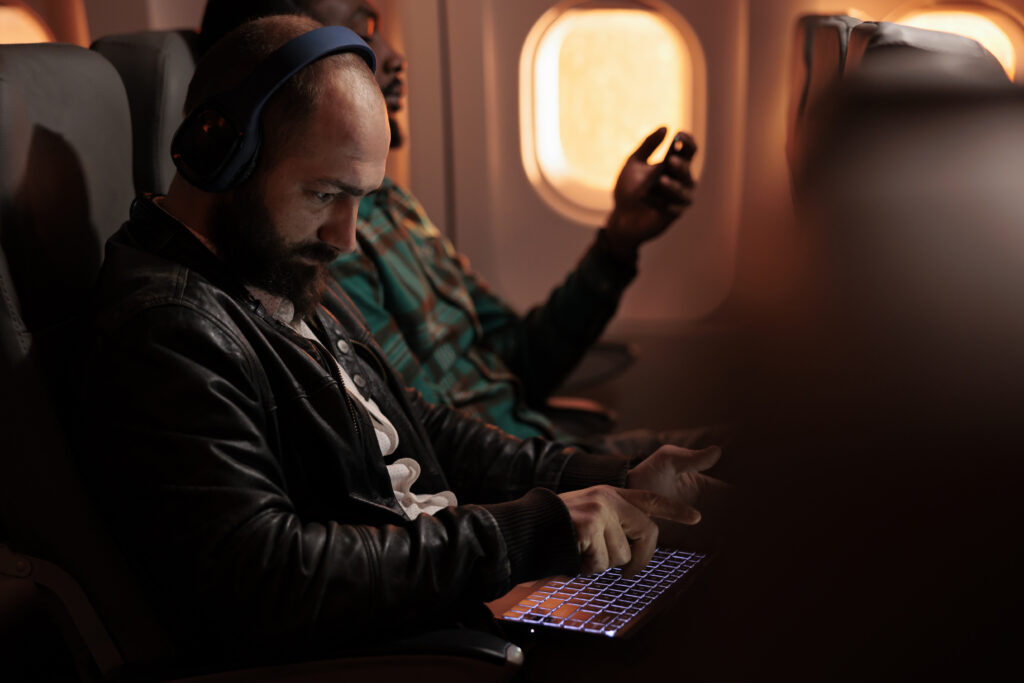
In today’s air travel landscape, passengers expect the same level of connectivity in the skies as they have on the ground. The ability to stay connected during a flight provides passengers with access to entertainment options and enables seamless communication with loved ones or colleagues. Recognising this demand, airlines prioritise connectivity as a key component of their service offerings.
In-flight connectivity (IFC) offers a more technologically savvy travel experience that meets passenger expectations. Additionally, IFC is seen to play a significant role in supporting airline efforts to deliver ancillary revenue and more efficient onboard service operations.
Connectivity and sustainability
The aviation industry is making strides towards the ambitious target of achieving ‘net zero carbon emissions by 2050.’ Currently responsible for over 90% of the sectors carbon footprint, efforts to reduce fuel emissions are of utmost importance.
However, from airport operations to cabin configurations, every aspect of aviation is being checked to mitigate its impact on climate change, including in-flight connectivity. Incorporating more environmentally friendly practices across the entire supply chain is crucial to embedding sustainability into aviation’s core.
IFC is progressively becoming more ubiquitous, with connectivity being a key factor in consumer decision-making. Research indicates that 82% of airline passengers prefer carriers offering quality Wi-Fi. Partly because of this driver, the in-flight entertainment and connectivity market is projected to reach $11.65 billion in 2030, registering a CAGR of 11.36%, according to Allied Market Research.
Key players such as Anuvu, Viasat Inc., Panasonic Corporation, and SITA (OnAir) are driving innovation. Plus, emerging growth opportunities are particularly evident in the Asia-Pacific, Middle East, and Latin American regions.
Beyond enhancing the passenger experience, in-flight connectivity significantly improves airlines’ operational efficiency. Real-time data transmission between aircraft and ground operations:
- facilitates proactive maintenance
- optimises fuel consumption
- and streamlines overall operations
All resulting in substantial cost savings and a more sustainable approach to air travel.
Experts anticipate that in-flight entertainment and connectivity systems will play a pivotal role in shaping a greener future for airlines. Several initiatives highlight this commitment, such as Aeromexico’s sustainability measures, which leverage Panasonic Avionics’ in-flight connectivity systems to minimise waste by enabling just-in-time sales. Similarly, AirFi’s innovative LEO solution, installed discreetly in aircraft windows, reduces drag by about 4%.
Furthermore, Intelsat’s Electronically Steered Array (ESA) antenna exemplifies technological advancements in IFC. Lightweight and has no moving parts, the less-than-three-inch-tall antenna significantly reduces fuel burn and carbon emissions while providing passengers with high-speed connectivity of up to 275 Mbps.
In-flight connectivity goes beyond mere internet access in the air; it offers many benefits for passengers, crew, and the aviation industry.
And the IFEC Zone at AIX serves as a hub for showcasing the latest advancements in in-flight connectivity and entertainment.

Processes and efficiency
In-flight connectivity empowers passengers to continue essential tasks such as email communication and web browsing during air travel. This ensures air travellers can remain in touch with clients or loved ones throughout their journey.
Complemented by in-flight entertainment systems, cabin electronics can elevate flight experiences and passenger productivity. Innovative lighting systems can synchronise with travellers’ circadian rhythms to combat jet lag, for example. While mood lighting, controllable via Cabin Management Systems (CMS) or mobile apps, further enhances ambiance.
“With better connectivity on the go, travel times have increasingly become working times. Now, airlines also want to offer connectivity so they can compete with the existing fast-train city-pair connections.”
David Fox, Vice President, In-flight & Connectivity Services, Deutsche Telekom
Optimising operations and safety
In-flight connectivity also serves as a valuable asset for airline operations.
IFC facilitates data analytics, monitoring usage patterns across airtime services, devices, and traffic categories. This data can inform targeted advertising solutions, drive onboard sales, and enhance the passenger experience.
In-flight connectivity systems also empower operations teams with access to flight planning and related services, ensuring efficient and safe flight operations.
Moreover, in-flight connectivity enables real-time monitoring for mechanical issues and swift response to potential emergencies, mitigating risks and enhancing safety protocols.
In-flight connectivity does all of these things. It should be able to provide reliable internet speeds, accommodate popular apps and tools used on the ground, and demonstrate durability and dependability across diverse flight paths.
In-flight connectivity not only keeps passengers engaged but also serves as a revenue-generating tool for airlines. By enhancing the overall customer experience, it fosters increased loyalty and positive recommendations, benefiting both airlines and passengers alike.
Connectivity technologies
Below are a few examples of in-flight connectivity solutions:
aWAP
aWAP solutions, like those developed for aerospace by ECA Group, combines a server and wireless access point to provide Wi-Fi coverage in aircraft cabins via the Wireless Local Area Network (WLAN). It enables operators to manage routes and allows for onboard shopping, and other services while offering passengers secure access to various entertainment options on their personal electronic devices (PEDs) through a secured network.
Lconnect
Lufthansa Technik’s Lconnect solutions swiftly deliver in-flight entertainment and connectivity to aircraft passengers. Offering broadband capabilities, Lconnect seamlessly integrates cockpit and flight operations with passenger and cabin crew services. Its adaptability ensures minor work on the aircraft and will require no major work if ever a need for advances in technology in the future arises.
Wireless Access Point (WAP)
Another in-flight connectivity option from Lufthansa Technik is the Wireless Access Point (WAP), which provides ultra-fast Wi-Fi connectivity tailored for aircraft environments. Optimised for high-density cabin settings, it features integrated antennas and easy airline configuration. With Gigabit Wireless Standard (802.11ac, 1.3 Gbps) capacity, it supports faster video streaming and internet connections, particularly suited for modern aircraft models like the Airbus A350 and Boeing 787.
Additional providers
Other notable companies offering in-flight entertainment and connectivity solutions include Thales, with their seatback IFE systems using AVANT Up’s Android based Operating System. AirFi, a leader in portable IFE and in-flight retailing technology, has a suite of solutions that enable IFE streaming, enhanced crew efficiency, and third-party commercial integrations.
Furthermore, ThinKom specialises in antenna systems interoperable across LEO, MEO, GEO, and HEO satellite constellations, ensuring robust connectivity options for the aviation industry.

What are the differences between LEO and GEO satellites?
The ongoing discourse within the industry revolves around the comparative effectiveness of satellite communications, specifically between LEO and GEO satellites. But what sets these two apart?
GEO satellites orbit at an altitude of around 36,000 kilometres above the Earth’s equator, synchronising with the planet’s rotation to complete a 24-hour orbit. Stationary in the sky, GEO satellites eliminate the need for Earth-based antennas to track or rotate.
In contrast, LEO satellites operate within lower orbits ranging from 500 to 2,000 kilometres in altitude, completing 12 orbits daily with an orbital period of up to 128 minutes. However, their smaller field of view restricts communication to only a fraction of the Earth at any given time, necessitating a network infrastructure for continuous coverage.
In terms of antenna requirements, ground stations serving GEO satellites don’t require adjustments to receive signals. However, due to the higher orbit, GEO antennas need to be larger to provide higher gains. Conversely, LEO satellites demand at least two or three ground-based antennas for seamless transition and tracking, ensuring consistent service by interfacing with multiple satellites and facilitating uninterrupted communication.
In the aviation industry, satellite-based connectivity is embraced to deliver global coverage and seamless connectivity for aircraft, regardless of their location. While GEO satellites boast broad coverage, they often suffer from higher latency due to the distance between the satellite and the aircraft. Meanwhile, LEO satellites, orbiting closer to Earth, provide both global coverage and low-latency connectivity, making them an appealing option for aviation applications.
In-flight connectivity, past to future
In the early 2000s, the rise of internet connectivity encouraged airline operators to explore bringing this innovation to air travel. Lufthansa made history by becoming the first airline to offer internet connectivity on a commercial flight route in 2004. However, this service was short-lived, ending in 2006 due to the complex nature of the required ‘Connexion hardware,’ weighing nearly 1,000 pounds (450 kg). The added weight and drag surpassed airlines’ tolerance levels.
But the groundwork laid during this period was never put to waste.
Today, several airlines have already been testing or using in-flight connectivity. Some of the airlines that have some measure of IFC capabilities at no extra cost include JetBlue, Norwegian Air, and Air New Zealand, as well as China Eastern Airlines and Philippine Airlines on select aircraft.
As passenger demand for online connectivity continues to soar, the future of in-flight connectivity appears promising. It has evolved from being a novelty to becoming an industry standard, reflecting the growing expectation of passengers to stay connected while flying.
“Within the next 5 years we as an industry rather have to focus on how to actually deliver against the passenger expectation, in a profitable manner.”
Dirk Lindemeier, Chief Commercial Officer, SkyFive AG
However, airlines must recognise that the performance of their in-flight connectivity offerings will be scrutinised by customers. Therefore, selecting a reliable network provider capable of delivering a seamless broadband experience to passengers is important.
Moreover, IFC providers must be flexible to adapt to airlines’ requirements, cover their global routes, and respond to demand in densely populated areas. This ensures that airlines can meet the evolving needs of their tech-savvy passengers while maintaining a competitive edge in the market.
Do aeroplanes have internet onboard?
Yes, many airlines provide Wi-Fi access onboard their aircraft. British Airways, for example, offers Wi-Fi for a fee, while Turkish Airlines and Emirates offer complimentary Wi-Fi access to certain club members. Many airlines are in the process of implementing Wi-Fi across their fleets.
What technologies allow aeroplanes to carry on-board Wi-Fi?
There are two primary methods for airplanes to access Wi-Fi: air-to-ground and Ku or Ka-band satellite connectivity.
Air-to-ground relies on cell towers that connect transmitted signals, providing connectivity to aircraft.
Meanwhile, some aircraft are equipped with antennas, which send and receive signals from satellites to deliver Wi-Fi access.
What are in-flight entertainment and connectivity?
In-flight connectivity encompasses any onboard technology that utilises an internet connection, enabling passengers, crew and aircraft to access online services. On the other hand, in-flight entertainment refers to the range of onboard options available to entertain passengers during their flight.
Together, in-flight entertainment and connectivity represent a suite of solutions that enable passengers to connect to the internet and access entertainment options while travelling by air.


